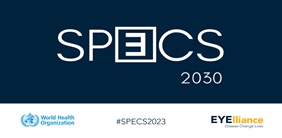22 September, 2025
Global SPECS 2030
Tue 29 Jul, 2025
Introduction:
In a landmark move toward promoting inclusive and accessible eyecare, the World Health Organization (WHO) has launched the ‘Global SPECS 2030’ initiative. This global campaign aims to ensure universal access to affordable eye health services by the year 2030, addressing a growing global burden of preventable visual impairments and refractive errors.
The Need for the Initiative:
- Globally, over 2.2 billion people suffer from vision impairment, and at least 1 billion cases are preventable or unaddressed, largely due to lack of access to basic eye health services such as eye exams and affordable glasses.
In developing and underdeveloped nations, this issue is compounded by the scarcity of trained eye care professionals, poor public awareness, and high cost of corrective eyewear.
Aim of Global SPECS 2030:
- The Global SPECS (Spectacle Services, Personnel, Education, Cost, Surveillance) 2030 initiative seeks to build an inclusive and coordinated global framework to eliminate avoidable vision problems. The core objective is to make refractive services and affordable eyeglasses accessible to all by the end of the decade.
Focus Areas – The SPECS Framework:
The initiative is structured around five critical pillars, forming the acronym SPECS:
| Component | Focus |
| S – Services | Improve accessibility and quality of refractive services like eye testing and prescriptions. |
| P – Personnel | Enhance training and distribution of skilled eye care professionals. |
| E – Education | Promote public awareness about eye health and early detection. |
| C – Cost | Lower the economic burden of eyeglasses and related services. |
| S – Surveillance | Strengthen data systems to monitor progress, research, and evaluation. |
Strategies for Implementation:
To support countries and stakeholders, WHO has outlined four key strategies to ensure effective implementation of the initiative:
1. Normative Work:
WHO will continue developing technical standards, toolkits, and guidelines for national governments to align eye care within public health systems.
2. Global SPECS Network:
This network will serve as a collaborative platform for knowledge sharing, capacity building, and collective advocacy among organizations, NGOs, health institutions, and educational bodies.
3. Private Sector Collaboration:
WHO will engage with private industry leaders—including optical, pharmaceutical, and tech sectors—to expand eyecare access and drive innovation in vision correction tools and devices.
4. Regional and National Engagement:
Countries will receive support in formulating context-specific policies, enabling local implementation of eye health services aligned with global goals.
Broader Impact & Importance:
- Vision impairment affects education, employment, and overall productivity, especially in low-income populations.
- Investment in eye health is shown to yield a high return, as vision correction leads to better academic and work performance.
- By integrating eyecare into universal health coverage (UHC), the initiative aligns with UN’s Sustainable Development Goals (SDGs)—particularly SDG 3 (Good Health & Well-being) and SDG 4 (Quality Education).
Relevance for India:
- India has a large burden of uncorrected refractive errors and cataract-related blindness. The SPECS 2030 initiative can strengthen national programs like the National Programme for Control of Blindness (NPCB) and support Ayushman Bharat’s health and wellness centers in delivering primary eye care services.
- With India’s ongoing digital and healthcare reforms, data surveillance and affordable optical solutions under SPECS can significantly boost vision outcomes in rural and underserved areas.


















